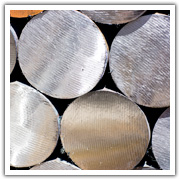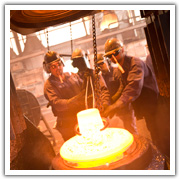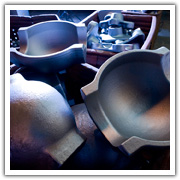 Die forging is a manufacturing process by which metal is pressed, pounded, or squeezed under great pressure into high-strength parts known as forgings. The process is normally (but not always) performed hot by preheating the metal to the desired temperature before it is worked. It’s important to note that the die forging process is entirely different from the casting (or foundry) process, as the metal used to make forged parts is never melted and poured (as in the casting process). Die forging refines the grain structure and improves the physical properties of the metal, so that the grain flow can be oriented in the direction of principal stresses encountered in actual use. Physical properties such as strength, ductility, and toughness are much better in a forging than in the base metal.
Die forging is a manufacturing process by which metal is pressed, pounded, or squeezed under great pressure into high-strength parts known as forgings. The process is normally (but not always) performed hot by preheating the metal to the desired temperature before it is worked. It’s important to note that the die forging process is entirely different from the casting (or foundry) process, as the metal used to make forged parts is never melted and poured (as in the casting process). Die forging refines the grain structure and improves the physical properties of the metal, so that the grain flow can be oriented in the direction of principal stresses encountered in actual use. Physical properties such as strength, ductility, and toughness are much better in a forging than in the base metal.
 Clifford-Jacobs forgings are normally made from special bar quality steel. As steel bars are rolled, the grain structure within the steel is forced to flow along the centerline of the bar. When a standard or custom forging is produced from the bar, this inherent grain flow bends to follow the contour of the forged shape, thus producing a superior part. Any machined part, whether produced from bars or plate, will, by definition, cut through part of the grain flow. Just about any metal can be forged. However, some of the most common include carbon, alloy, and stainless steels; very hard tool steels; aluminum; titanium; brass and copper; and high-temperature alloys which contain cobalt, nickel, or molybdenum. Each metal has distinct strength or weight characteristics that best apply to specific parts as determined by the customer.
Clifford-Jacobs forgings are normally made from special bar quality steel. As steel bars are rolled, the grain structure within the steel is forced to flow along the centerline of the bar. When a standard or custom forging is produced from the bar, this inherent grain flow bends to follow the contour of the forged shape, thus producing a superior part. Any machined part, whether produced from bars or plate, will, by definition, cut through part of the grain flow. Just about any metal can be forged. However, some of the most common include carbon, alloy, and stainless steels; very hard tool steels; aluminum; titanium; brass and copper; and high-temperature alloys which contain cobalt, nickel, or molybdenum. Each metal has distinct strength or weight characteristics that best apply to specific parts as determined by the customer.
 Die forging is superior to casting or machining bar stock because the metal’s natural grain flow is made to conform to the shape of the product. Castings have an isotropic grain structure and, for a given part, may be as strong in compression loads, but standard and custom forgings are superior in tensile and shear loads due to the utilization of the grain flow. The structural reliability of die forgings allows designers to trust the material to adhere to the safety factors of the design. It also can provide a more uniform response to heat treatment and machining operations. The forging process can create parts that are stronger than those manufactured by any other metalworking process. This is why forgings are almost always used when reliability and human safety are critical.
Die forging is superior to casting or machining bar stock because the metal’s natural grain flow is made to conform to the shape of the product. Castings have an isotropic grain structure and, for a given part, may be as strong in compression loads, but standard and custom forgings are superior in tensile and shear loads due to the utilization of the grain flow. The structural reliability of die forgings allows designers to trust the material to adhere to the safety factors of the design. It also can provide a more uniform response to heat treatment and machining operations. The forging process can create parts that are stronger than those manufactured by any other metalworking process. This is why forgings are almost always used when reliability and human safety are critical.
How die forgings compare to castings
Forgings are stronger. Casting cannot obtain the strengthening effects of hot and cold working. Forging surpasses casting in predictable strength properties–producing superior strength that is assured, part to part. Forging refines defects from cast ingots or continuous cast bar. A casting has neither grain flow nor directional strength and the process cannot prevent the formation of certain metallurgical defects. Pre-working forge stock produces a grain flow oriented in directions requiring maximum strength. Dendritic structures, alloy segregations, porosity, voids, inclusions, and imperfections are refined in forging. Thus finishing operations, such as machining, do not expose voids because there aren’t any. Also, coating operations, such as plating or painting, are straightforward due to a good surface, which needs very little preparation.
Reliable standard and custom forgings are manufactured without the added costs for tighter process controls and inspections that are required for casting. Castings require close control of melting and cooling processes because alloy segregation may occur. Forging’s flexible production adapts to demand. Some castings, such as special performance castings, require expensive materials and process controls, and longer lead times. Open-die and ring rolling are examples of forging processes that adapt to various production run lengths and enable shortened lead times. So forgings are more cost-effective than castings.
How die forgings compare to machined bar/plate
Forgings offer a broader size range of desired material grades. The sizes and shapes of products made from steel bar and plate are limited to the dimensions in which these materials are supplied. Often, die forging may be the only metalworking process available with certain grades in desired sizes. Forgings can be economically produced in a wide range of sizes from parts whose largest dimension is less than one inch to parts weighing more than 450,000 pounds.
Forgings have grain oriented to shape for greater strength. Machined bar and plate may be more susceptible to fatigue and stress corrosion because machining cuts through the material grain pattern. In most cases, die forging yields a grain structure oriented to the part shape, resulting in optimum strength, ductility, and resistance to impact and fatigue. Forgings make better, more economical use of materials. The flame cutting plate is a wasteful process, one of several fabricating steps that consume more material than needed to make such parts as rings or hubs. Even more, is lost in subsequent machining. Forgings yield lower scrap and greater, more cost-effective production.
Forgings, especially near-net shapes, make better use of material and generate little scrap. In high-volume production runs, die forgings have a decisive cost advantage. Forgings require fewer secondary operations. As supplied, some grades of bar and plate require additional operations such as turning, grinding and polishing to remove surface irregularities and achieve the desired finish, dimensional accuracy, machinability and strength. Often, forgings can be put into service without expensive secondary operations.
Types of forging processes
Impression Die Forgingpounds or presses metal between two dies (called tooling) that contain a precut profile of the desired part. Parts from a few ounces to 60,000 pounds can be made using this process.
Cold Forging is more unusual because most forging is done as hot work, at temperatures up to 2,300 degrees F. Cold forging encompasses many processes–bending, cold drawing, cold heading, coining, extrusions and more, to yield a diverse range of part shapes. The temperature of metals being cold forged may range from room temperature to several hundred degrees.
Open Die Forging is performed between flat dies with no precut profiles is the dies. The movement of the workpiece is the key to this method. Larger parts over 200,000 pounds and eighty feet in length can be hammered or pressed into shape this way.
Seamless Rolled Ring Forging is typically performed by punching a hole in a thick, round piece of metal (creating a donut shape), and then rolling and squeezing (or in some cases, pounding) the donut into a thin ring. Ring diameters can be anywhere from a few inches to thirty feet.
